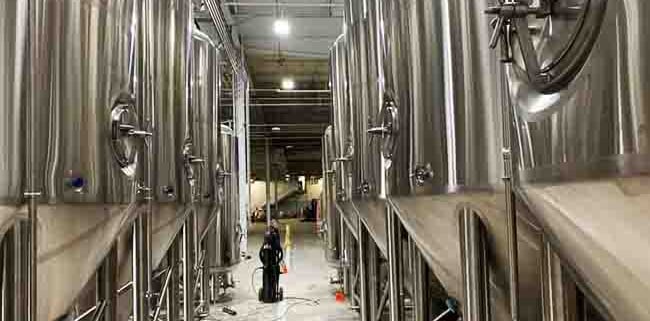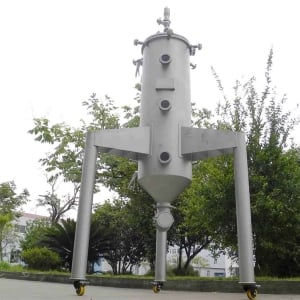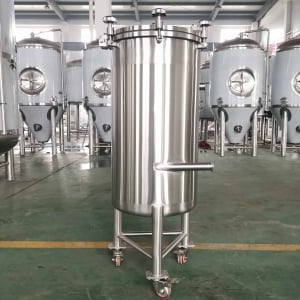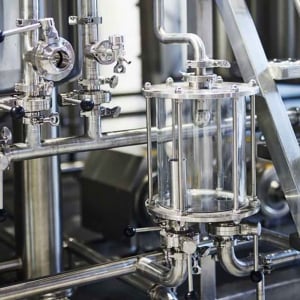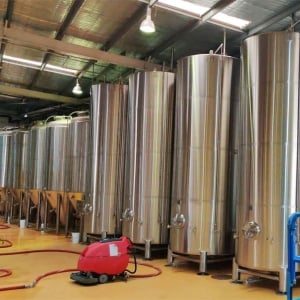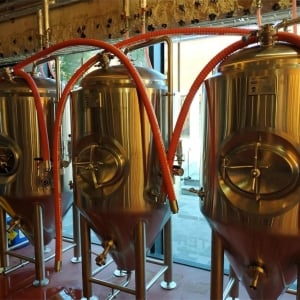Overview of 10 BBL Jacketed Fermenters
A 10 barrel (BBL) jacketed fermenter is a critical piece of equipment for intermediate-scale craft breweries producing approx. 3,100 gallons or 12,000 liters of beer per batch. This stainless steel vessel allows precision temperature control during fermentation through its hollow double-walled jacket that circulates heating or cooling media.
10 BBL fermenters offer a step up in capacity from pilot systems while still allowing craft brewers to produce a variety of beers in batches large enough for wider distribution. They represent an ideal balance between flexibility and higher volume production.
This guide covers key considerations in selecting, installing and operating 10 BBL jacketed fermenters to meet a brewery’s production goals and business growth plans. It compares different 10BBL fermenter types, sizes, designs, suppliers and prices to help brewers make informed purchasing decisions.
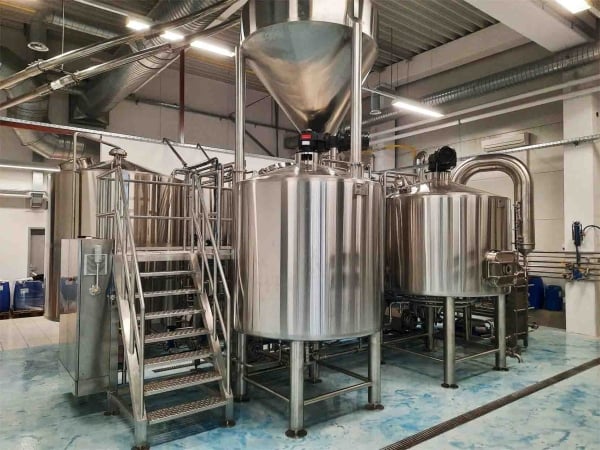
10 BBL Fermenter Equipment Guide
| Type | Description |
|---|---|
| Jacketed Fermenters | Stainless steel vessels with hollow outer jacket for temperature control via glycol, steam, cooling water or refrigerant. Offer precise regulation of fermentation environment. |
| Cylindroconical Fermenters | Cone-shaped bottom to allow yeast sedimentation. Have advantages for yeast handling and fermentation efficiency. |
| Uni-tank Fermenters | Combine fermentation and aging/maturation/conditioning in one tank. Simplify processes. |
| Open Fermenters | Older simpler design without jackets. Limited temperature control or yeast handling capacity. Cheaper. |
| Elevated Fermenters | Enable gravity flow transfer to bright beer tanks. Improve productivity, reduce labor. |
Key Design Elements
Well-designed 10 BBL fermenters balance features to support essential brewing functions like:
Precision Temperature Control: Jacketed for reliable warmth to promote yeast growth or cooling to settle yeast.
Yeast Handling: Cone bases and large smooth drain valves for complete yeast harvesting.
Sanitation & Cleaning: Round interior limits bacterial growth. Smooth CIP ball spray equipment.
Quality & Consistency: Total fermentation environment control for clean, flawless beer.
Flexibility & Innovation: Modular upgrades like elevated tanks or glycol systems allow customization over time as business expands past its original plan.
Popular 10 BBL Fermenter Sizes
| Capacity | Dimensions | Description |
|---|---|---|
| 10 BBL | Diameter: 5-6 ft Height: 6.5 – 8 ft | Standard craft brewery scale |
| 7 BBL | Diameter: 4-5 ft Height: 5 – 7 ft | Smaller capacity for flexibility |
| 15 BBL | Diameter: 6-7 ft Height: 8 – 10 ft | Larger capacity for production efficiency |
| 20 BBL | Diameter: 7-8 ft Height: 9 – 12 ft | High-volume production |
| 30 BBL | Diameter: 8-10 ft Height: 10 – 14 ft | Large regional brewery capacity |
The 10 BBL size balanced against 7 or 15 BBL configurations depends on current and future production targets, number of beer recipes, and physical brewery space constraints.
Fermenter System Design Parameters
| Feature | Options | Pros | Cons |
|---|---|---|---|
| Construction Material | Stainless Steel (304, 316) | Durable, corrosion-resistant | Expensive |
| Aluminum | Affordable, lightweight | Can react with wort, hard to repair | |
| Jacket Design | Half-jacket | Better cooling efficiency | Temperature gradients |
| Full-jacket | Even thermal profile | Additional fabrication complexity | |
| Interior Surface | Polished | Easy cleaning & inspection | |
| Unpolished | Lower cost | ||
| Cooling Method | Glycol system | Precise control & wide temp range | Higher complexity & cost |
| Cold liquid/water | Simple, less equipment | Temp regulation capacity limited | |
| Insulation | Foam | Maximize thermal efficiency | Difficult to inspect surface fully |
| Air | Lower efficiency but easy inspection | Some temperature fluctuation |
Additional choices around manways, thermowells, stand designs and upgrades like elevated, piloted, or conical fermenters determine functionality, price and customization flexibility.
Glycol Jacket Control Systems
Many 10 BBL fermenters have an exterior glycol jacket allowing coolant to circulate through channels to regulate tank temperature evenly and precisely.
| Type | Pros | Cons |
|---|---|---|
| Single Jacket | Lower Cost | Less Control |
| Half-Jacket (cool only) | Better Cooling Efficiency | Can’t Heat Tank |
| Full Jacket (heating & cooling) | Precise Bi-Directional Control | Complexity, Higher Price |
Key Glycol System Components:
- External heat exchanger with pumps to chill/heat water or food-grade glycol
- Insulated piping from chiller to jackets and back
- Control panel to set temperatures and circulation parameters
- Glycol reservoir tank sized for system capacity
- Recirculation pump sized correctly for pressure drop
Properly designed and sized glycol systems enable ales to ferment between 60°F and 70°F while lagers can condition down closer to 32°F. Getting fermentation parameters right is critical for quality and consistency.
Choosing Among 10 BBL Fermenter Manufacturers
With over 500 fermenter suppliers across North America, narrowing down to reputable firms for 10 BBL vessels involves assessing:
Experience: Number of years in business and breweries served successfully
Quality: Tank welding, finishing, reliability, warranty
Customization: Ability to meet specialized functionality needs
Customer Service: Responsiveness to quote, design, troubleshoot
Capabilities: End-to-end solutions from piloting to cellaring
Location: Proximity for shipping costs, installation, service
| Supplier | Location | Price Range |
|---|---|---|
| JV Northwest | Canby, OR; Avon, NY | $18,000-$38,000 |
| Ss Brewtech | Stowe, VT; Windsor, CA | $22,000-$42,000 |
| Psycho Brew | Louisville, KY | $30,000 – $50,000 |
| Diversified Metal Engineering | Clackamas, OR | $32,000-$60,000 |
| American Beer Equipment | Lincoln, CA | $25,000 – $46,000 |
Pricing for custom 10 BBL fermenter systems ranges widely from $15,000 to over $100,000 depending on configurations. Expect to budget $35,000 to $65,000 for a complete production-scale system. Get quotes from multiple vendors once specifications are set.
10 BBL Fermenter Buyer’s Checklist
Ensure fermenters match brewery’s current and future objectives using this checklist:
- Size meets batch production targets
- Material grade, insulation, jackets support beer styles
- Dimensions fit brewhouse flows and space
- Temperature specs align to fermentation needs
- Yeast handling supports harvesting goals
- Cleaning & maintenance access designed properly
- Control interface easy to operate
- Support for upgrades like elevating later
- Reliable vendor with quick support
10 BBL Fermenter Installation Guide
Proper fermenter installation is critical for safety, performance and longevity:
| Task | Method |
|---|---|
| Lifting & Placing | Use licensed rigging crew with correct spreader bar, bands, lift points for 10 BBL weight |
| Leveling & Anchoring | Ensure solid flat floor, level fermenter, anchor firmly |
| Structural Support | Construct secure platform if elevating tanks; reinforce roof, beams for weight |
| Ventilation | Design cooling flows for glycol pipes, control panels; avoid excess moisture |
| Layout | Ensure adequate clearance for ventilation, cooling lines, CIP, transfers |
| Safety Equipment | Mount lights, rails, access ladder for confined space entry if manways present |
Poor installation leading to tipped, dropped or damaged fermenters can significantly impact brewery operations. Invest in structural and facility upgrades in older buildings prior to new tank deliveries.
10 BBL Fermenter Operations
Optimal procedures for fermenter filling, monitoring, and yeast handling:
| Function | Method | Tips |
|---|---|---|
| Filling | Pump cooled wort gently into bottom of fermenter until reaching correct batch volume | Avoid splashing and aeration after chillers |
| Yeast Pitching | Aerate wort fully prior to adding; ensure yeast is active, double pitch at higher gravities | Pitch rate calculator to gauge inoculation correctly |
| Sealing | Carefully insert properly cleaned cooling jackets, inspect all door seals and clamp down | No contamination once sealed; take gravity reading from sample port |
| Temperature Control | Set chiller or glycol control points to target ale/lager profile | Make adjustments slowly over hours |
| Monitoring | Use cleaned/sanitized thermowells and hydrometers only, write diligent logs | Watch krausen, sample flavors daily after 50% fermentation |
| Yeast Harvesting | Drain yeast slowly into sanitized receiver vessel at peak flocculation | May involve CIP wash first if much trub present |
| Dry-Hopping | Add hop pellets/cones via tank hatch after active fermentation finishes | Allow contact for 5-7 days max, cold condition afterward |
| Fruit Additions | Cleaned/sanitized fruit added through hatch, puréed if possible | Take care to minimize oxygen intake |
| Clarity & Yield | Fine with vegan agents or filter if needed after cooling post-fermentation; calculate actual vs theoretical yield | Fining and filtering processes dependent on beer style |
10 BBL Fermenter Cleaning & Maintenance
| Task | Method | Frequency |
|---|---|---|
| Interior Inspection | After fully draining batches, enter manway to check surfaces, seals, welds and any installed parts for pits, cracks, leaks or damage | Monthly |
| Clean-Out | Initial rinse with water, then alkaline or acidic cleaner recirculation with tank sprays and agitation through CIP pumps | After each batch completion |
| Sanitation | Final pass with dilute sanitizer left to contact surfaces then drained | Right before the next batch starts |
| Chiller Maintenance | Inspect and delime jacket coolant lines and control valves if mineral deposits present | Quarterly |
| Door Replacement | Check door seals during inspection and replace as needed if any are loose, cracked, or not sealing fully | Yearly |
| Performance Testing | Calibrate temp sensors and other instruments annually at a minimum to ensure proper readings | Yearly |
Proactive fermenter maintenance keeps beer clean and equipment in good working order over decades of service life.
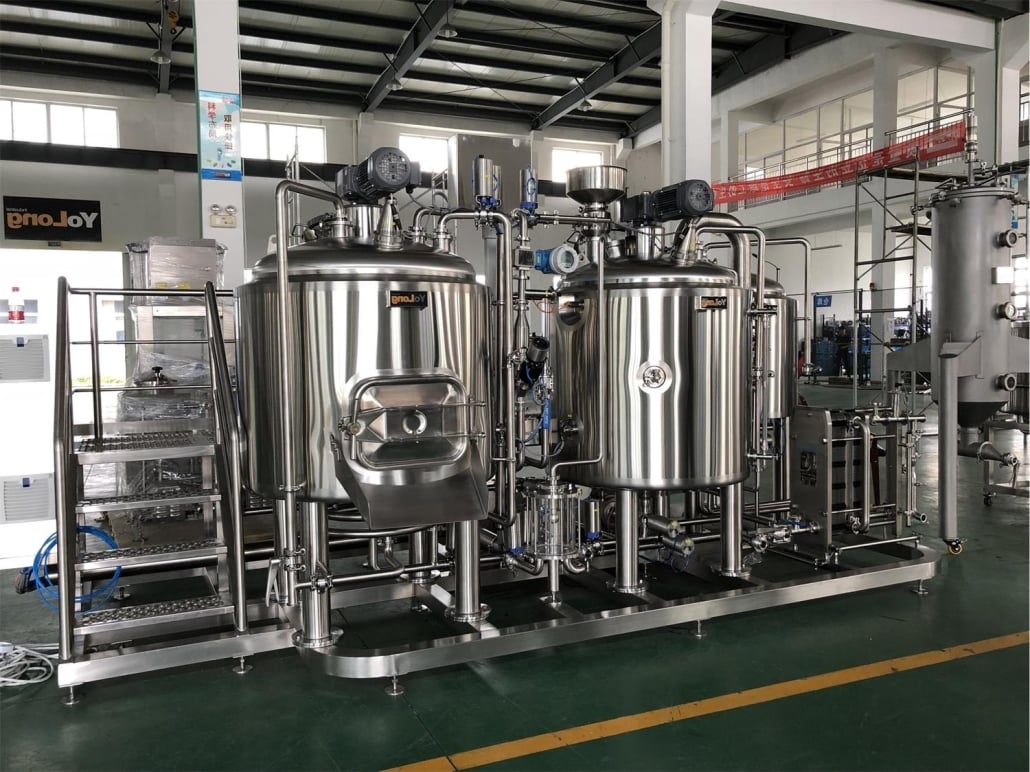
Comparing Pros and Cons of 10 BBL Fermenter Options
| Type | Pros | Cons |
|---|---|---|
| Piloted | Conical bottom improved yeast removal and trub settling; better hop separation | Much more expensive, space intensive |
| Uni-tank | Simplified transfers, faster overall cycle time | Restricts some processes, customization capability |
| Elevated | Gravity transfers instead of pumps, less oxidation | Structural requirements, max height limits |
| Half vs Full Jacket | Cheaper initial cost, uses single utility | Less precise temperature control |
| Imported | Often cheaper but non-customized | Long lead times, lacking support |
| Remanufactured | Save money over new price with some refurbishment | Limited configurations, less warranty coverage |
Evaluate tradeoffs between price, quality and functionality closely aligned to the brewing process requirements.
FAQ
What are the maximum and minimum temperatures a 10 BBL glycol jacketed fermenter can achieve?
The system can cool down to 32°F for cold conditioning lagers and heat up to 75°F to promote ale yeast growth and activity using propylene glycol. Temperature capabilities depend on the chiller units and control sensors precision.
How many years should a 10bbl fermenter reasonably last under normal commercial brewing operations?
With proper installation, cleaning and maintenance, 10 BBL stainless steel fermenters should last 25-30 years in commercial production environments before needing significant repairs or replacement.
Can standard 10 BBL fermenters handle sour or wild fermentation with bacteria safely?
Certain enhanced stainless steel alloys resist bacteria adhesion and corrosion better if producing sours. But standard fermenters require very intensive cleaning and sanitation regimens, full-vessel acid washes between batches along with replacing door gaskets/seals to prevent cross-contamination. Dedicated sour tanks are safer long-term.
What are the most frequent 10 BBL fermenter repairs needed outside the typical cleaning and servicing?
Door seal replacements, cooling jacket leaks at welded seams, and replacing spray balls or thermowells are the most common maintenance fixes for actively used 10 BBL tanks. Major repairs like bottom replacement or entire new cooling jackets are rare before 25+ years if well-fabricated initially.
Can standard jacketed 10 BBL fermenters handle fruit or dry hopping additions effectively?
Yes – clean fruits can be introduced post-primary fermentation through the top manways once fermenters are sealed off. Dry hopping also occurs best after active fermentation subsides so aroma is preserved. Introduction of solids or adjuncts later benefits from removable screen panels over tank bases to allow drainage while retaining hop particles or fruit inside.

